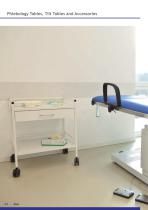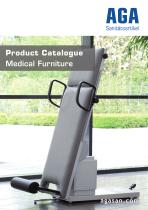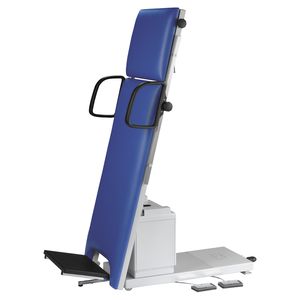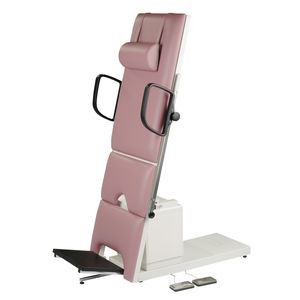
- Furniture, Logistics
- Patient transfer
- 2-section tilt table
- AGA Sanitätsartikel
- Company
- Products
- Catalogs
- News & Trends
- Exhibitions
2 sections tilt table KT-1080/EE therapyelectricon casters







Add to favorites
Compare this product
Characteristics
- Number of sections
- 2 sections
- Other characteristics
- therapy, electric, on casters, height-adjustable
Description
Therapeutic tilt tables, also known as standing boards, can be used for various therapy methods. Among other things, they enable the patient to be raised up continuously from the shock or lying position to the almost vertical position. These models are therefore ideal for the treatment of neurological diseases as well as head and back injuries or paraplegic patients.
In order to give the patient the physical and psychological safety required during treatment and when getting on and off, the combination of the upholstery cutout at the foot end with the extra-large, removable footboard was developed for the tilting tables.
Features
The therapy tilt tables can be adjusted by electric motors from the vertical position (90°) to the horizontal position (0°). The tilting is controlled using a hand switch (alternatively, at no extra charge, with a foot switch).
The electromotive height adjustment (520 – 960 mm, measured in the horizontal upholstery position) is controlled via a foot switch (alternatively, at no extra charge, via a hand switch).
The height and tilt adjustments are done with maintenance-free and splash-proof and extremely quiet electric drives equipped with key locks. Connection values per motor: 230V, 50/60 Hz., 3.7A, 850W, IPX4, v=11mm/s, 10,000N.
The wide support frame, which is equipped with a mobile base on retractable castors, ensures a high level of stability, even under stress.
The mobile base on retractable castors, swivel castors Ø 75 mm, locked in place using pedals are by pedals at the head and foot ends (step twice).
The headrest can adjusted up to +35° using a grid with 13 locking steps.
VIDEO
Catalogs
Phlebology Tilt Tables
8 Pages
Other AGA Sanitätsartikel products
Phlebology Tables and Tilt Tables
Related Searches
- AGA stretcher trolley
- AGA transport stretcher trolley
- Infusion stand
- Infusion stand on casters
- Height-adjustable gurney
- Mechanical stretcher trolley
- 4-hook IV stand
- Stainless steel IV stand
- AGA 2-section stretcher trolley
- AGA stretcher trolley with adjustable backrest
- Emergency stretcher trolley
- Tilting stretcher trolley
- Hydraulic stretcher trolley
- Trendelenburg gurney
- 2-hook IV stand
- Stretcher trolley with side rails
- Stainless steel stretcher trolley
- Telescopic IV pole
- Patient transfer stretcher trolley
- Rail-mounted IV stand
*Prices are pre-tax. They exclude delivery charges and customs duties and do not include additional charges for installation or activation options. Prices are indicative only and may vary by country, with changes to the cost of raw materials and exchange rates.












